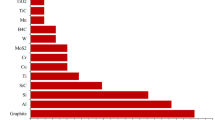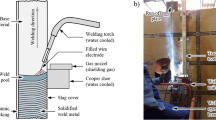Abstract
Electrical discharge grinding has large potential application prospect in Inconel 718 machining. Surface integrity of Inconel 718 in electrical discharge grinding is characterized by a variety of methods in the paper. The ground surface morphology is observed by scanning electron microscope. Electrical discharge grinding zone and pure grinding zone are generated on the ground surface in electrical discharge grinding. Electrical discharge grinding zone increases with the increases of depth of cut, feed speed, voltage, current, and the ratio of pulse width to pulse interval. Subsurface grain deformation is detected by means of electron backscatter diffraction method. In electrical discharge grinding zone, local misorientations are much less than those in pure grinding zone. Moreover, they tend to distribute along the grain boundaries in pure grinding zone. Moreover, there is almost no recrystallization in both types of zones. Electrolytic corrosion method is adopted to investigate the corrosion resistance. It is found that the corrosion resistance of electrical discharge grinding zone is much poorer than that of pure grinding zone. Furthermore, nano-indentation experiment is executed to explore the nano-mechanical properties. The results show that the hardness and modulus of material from low to high are respectively electrical discharge grinding, bulk, and pure grinding. It also indicates that the recast layer could be removed more easily during subsequent precision machining.










Similar content being viewed by others
References
De Bartolomeis A, Newman S T, Biermann D et al (2021) State-of-the-art cooling and lubrication for machining Inconel 718. J Manuf Sci Eng 143(5):050801 (19 pages)
De Bartolomeis A, Newman ST, Jawahir IS, Biermann D, Shokrani A (2021) Future research directions in the machining of Inconel 718. J Mater Process Technol 297:117260
Pereira O, Celaya A, Urbikaín G, Rodríguez A, Fernández-Valdivielso A, de Lacalle LNL (2020) CO2 cryogenic milling of Inconel 718: cutting forces and tool wear. J Market Res 9(4):8459–8468
Elsheikh AH, Muthuramalingam T, Shanmugan S, Ibrahim AMM, Ramesh B, Khoshaim AB, Moustafa EB, Bedairi B, Panchal H, Sathyamurthy R (2021) Fine-tuned artificial intelligence model using pigeon optimizer for prediction of residual stresses during turning of Inconel 718. J Market Res 15:3622–3634
Jia Z, Lu X, Gu H, Ruan F, Liang SY (2021) Deflection prediction of micro-milling Inconel 718 thin-walled parts. J Mater Process Technol 291:117003
Koshy P, Jain VK, Lal GK (1996) Mechanism of material removal in electrical discharge diamond grinding [J]. Int J Mach Tools Manuf 36(10):1173–1185
Zulafif Rahim M, Ding S, Mo J (2015) Electrical discharge grinding of polycrystalline diamond—effect of machining parameters and finishing in-feed. J Manuf Sci Eng 137(2):021017 (11 pages)
Yadav RS, Yadava V (2017) Experimental investigations on electrical discharge diamond peripheral surface grinding (EDDPSG) of hybrid metal matrix composite [J]. J Manuf Process 27:241–251
Rao X, Zhang F, Lu Y et al (2020) Surface and subsurface damage of reaction-bonded silicon carbide induced by electrical discharge diamond grinding [J]. Int J Mach Tools Manuf 154:103564
Kozak J, Zybura-Skrabalak M, Skrabalak G (2016) Development of advanced abrasive electrical discharge grinding (AEDG) system for machining difficult-to-cut materials [J]. Procedia CIRP 42:872–877
Agrawal S, Yadava V (2013) Modeling and prediction of material removal rate and surface roughness in surface-electrical discharge diamond grinding process of metal matrix composites [J]. Mater Manuf Processes 28(4):381–389
Yao CF, Jin QC, Huang XC, Wu DX, Ren JX, Zhang DH (2013) Research on surface integrity of grinding Inconel718. Int J Adv Manuf Technol 65(5):1019–1030
Miao Q, Ding W, Kuang W, Yang C (2020) Comparison on grindability and surface integrity in creep feed grinding of GH4169, K403, DZ408 and DD6 nickel-based superalloys. J Manuf Process 49:175–186
Zeng Q, Liu G, Liu L, Qin Y (2015) Investigation into grindability of a superalloy and effects of grinding parameters on its surface integrity. Proc Inst Mech Eng B J Eng Manuf 229(2):238–250
Sinha MK, Setti D, Ghosh S, Rao PV (2016) An investigation on surface burn during grinding of Inconel 718. J Manuf Process 21:124–133
Wang J, Xu J, Wang X, Zhang X, Song X, Chen X (2019) A comprehensive study on surface integrity of nickel-based superalloy Inconel 718 under robotic belt grinding. Mater Manuf Processes 34(1):61–69
Izquierdo B, Plaza S, Sánchez JA, Pombo I, Ortega N (2012) Numerical prediction of heat affected layer in the EDM of aeronautical alloys. Appl Surf Sci 259:780–790
Li L, Wei XT, Guo YB, Li W, Liu JF (2014) Surface integrity of Inconel 718 by wire-EDM at different energy modes. J Mater Eng Perform 23(8):3051–3057
Ayesta I, Izquierdo B, Flano O, Sánchez JA, Albizuri J, Aviles R (2016) Influence of the WEDM process on the fatigue behavior of Inconel® 718. Int J Fatigue 92:220–233
Funding
This work was supported by the National Natural Science Foundation of China (Grant number 51875137).
Author information
Authors and Affiliations
Contributions
Junqi Wei: methodology, validation, writing — original draft. Yong Zhang: conceptualization, methodology, supervision, project administration, resources, funding acquisition. Guojun Dong: validation, writing — review and editing. Liangchi Zhang: conceptualization, methodology, supervision. Feihu Zhang: validation, resources, supervision.
Corresponding author
Ethics declarations
Competing interests
The authors declare no competing interests.
Additional information
Publisher's note
Springer Nature remains neutral with regard to jurisdictional claims in published maps and institutional affiliations.
Rights and permissions
Springer Nature or its licensor (e.g. a society or other partner) holds exclusive rights to this article under a publishing agreement with the author(s) or other rightsholder(s); author self-archiving of the accepted manuscript version of this article is solely governed by the terms of such publishing agreement and applicable law.
About this article
Cite this article
Wei, J., Zhang, Y., Dong, G. et al. Surface integrity of Inconel 718 in electrical discharge grinding. Int J Adv Manuf Technol 123, 3275–3283 (2022). https://doi.org/10.1007/s00170-022-10400-2
Received:
Accepted:
Published:
Issue Date:
DOI: https://doi.org/10.1007/s00170-022-10400-2




